The Role of Non-Energy Impact Assessment in Boosting Energy Efficiency and Urban Regeneration Projects: The RenOnBill Project and Experiences from Liguria Region
Abstract
1. Introduction
2. Urban Regeneration and Energy Efficiency in Italy: The State of the Art
2.1. Urban Regeneration Project Evolution in Italy
2.2. Enhancing Resilience through the Upscaling of Energy Efficiency Interventions
3. Assessing Non-Energy Benefits: Case Studies
3.1. C40 Global Network—Benefits of Deep Retrofits
- New jobs: This benefit can be calculated by applying multipliers to the overall capital investments made for the retrofit. Multipliers are available for both direct, indirect and induced jobs. Overall job creation ranges between 13 and 28 jobs per EUR 1 million invested;
- Asset value: This parameter represents sale and rent premiums associated with energy-efficient buildings. In some cases, a cost premium has been linked to an increase in energy label;
- GVA: The literature has shown relationships that support estimates of increases in GDP per million invested or per number of jobs created. In addition, fiscal multipliers are identified that show the relationship between GDP increase and increase in public budget;
- NPV: Operational and maintenance cost savings can be calculated based on energy savings as well as components such as lifetime and replacement needs. Productivity gains can be included in net present value calculations based on staff costs;
- Energy poverty: The reduction in the number of households in energy poverty conditions can be estimated using data on energy savings, fuel costs and household incomes;
- Health conditions, in terms of:
- (a)
- Thermal comfort: Risk multipliers linking decrease in indoor temperature to increase in mortality due to cardiovascular diseases;
- (b)
- Indoor Air Quality: The literature review identified asthma as a risk factor in mouldy and damp houses. A relationship is identified linking mould and dampness improvements after the retrofit to reductions in the incidence of asthma;
- (c)
- Noise: Epidemiological relationships linking noise levels and population exposure to CVD morbidity;
- Productivity: The literature showed productivity increases for various improvements of building environment characteristics;
- Outdoor Air Quality: When large portions of the building stock are retrofitted, paying particular attention to heating systems, outdoor air quality improves, and calculating methodologies have already been implemented.
- City context: city name, country, currency, currency symbol and year that the project started.
- Demographic data: city population data. If available, collect data for population by gender and age.
- Action data: Define your action: building typology, number of buildings/households retrofitted, population in retrofitted buildings, average number of people per building/household, floor area of retrofitted buildings (heated), time horizon for energy savings, time lag between investment and operation start, capital investment. Select the retrofit components of your action by selecting Yes or No for each retrofit category (i.e., envelope, glazing, HVAC, lighting, controls) or specify it if the retrofit component is not listed.
- Fuel consumption data: Collect data on fuel consumption pre- and post-action and define the performance gap and rebound effect (i.e., use default values or input local energy savings reduction factors).
- Fuel data: If future fuel data are not available, prices may be assumed to be constant over time or proxy data may be used, provided that the assumptions are transparently communicated when discussing outcomes. Input current and future fuel prices (i.e., natural gas, electricity, biomass, coal, oil prices) and input GHG emission factors (i.e., natural gas, electricity, biomass, coal, oil).
- Jobs data: Collect jobs multipliers to calculate total full-time equivalent (FTE) jobs created per million invested (i.e., lower, median and upper bound values) and define the proportion of direct, indirect and induced jobs created for your city.
- NPV set-up data: Identify the project discount rates and carry out a sensitivity analysis, testing at least two different scenarios. According to the European Union Cost Optimal Regulation (2012), the analyzed discount rate should be 3%. Define your economic framework (i.e., if the city will use ESCO companies to finance the programme, define the ESCO duration, the percentage of capital investment covered by ESCO, the percentage of savings going to ESCO, the percentage passed on to the consumer, the percentage of savings going to the owner) and define whether the programme will have an impact on building lifetime extension (i.e., define the value of one extra year of building lifetime and the increase in building lifetime due to the retrofit). The NPV calculation follows the typical financial formula used to evaluate the difference between the present monetary value of the project and future cash flows.
- Retrofit economic incentives: Define whether the programme is benefitting from any capital (i.e., define whether the city is benefitting from grants and whether the grant is determined as a percentage of CAPEX or a specific value and express it accordingly) or operational incentives (i.e., define incentive value and incentive duration).
- Maintenance data: In a simplified scenario, collect current maintenance costs and maintenance cost reduction post-action. In a detailed scenario, for each retrofit category, collect frequency of maintenance data pre- and post-action and the average maintenance cost of one building/household.
- Productivity data (office and school only): Define the total productivity increase (as a percentage) and the productivity value (i.e., staff cost expressed per year).
- Income distribution data (residential only): Define the income distribution for the retrofitted building’s population (i.e., the number of households in the lower and upper income bounds).
- Cold temperature-mortality input data (residential only): Collect temperature data (i.e., expected indoor average temperature increase due to the action); collect health data (i.e., baseline mortality rate and mortality by age and gender); and define the local cold temperature-mortality multiplier.
- Mould/damp–asthma input data (residential only): Based on a survey of the city or assumptions, define mould and damp data (i.e., the percentage of the population living in mouldy homes within retrofitted buildings and the effectiveness of retrofits to reduce mould/damp); collect asthma prevalence rate and define the relation between prevalence of asthma and the presence of mould/dampness (i.e., mould/damp–asthma risk ration).
- Job multipliers;
- Cold mortality multipliers; and
- Mould–asthma risk ratios.
- New York focused on 23 public schools with particularly high emissions where the following retrofitting interventions have been implemented: glazing, insulation, HVAC, lighting, controls, solar PV and building management systems. In Table 3 one can find a single benefits quantification.
- Milan sought to model the benefits of retrofitting five multi-family residential buildings. The five residential buildings are predominantly privately owned and are historic in nature. The planned energy retrofits vary per buildings but include improvements to the building envelopes, glazing, HVAC, lighting, energy controls and PV panels. A benefits quantification is presented in Table 4.
- For the pilot study, Copenhagen focused on the deep energy retrofitting of five schools among 80 city-run schools. The planned energy retrofit includes improvements to the building envelopes, glazing, HVAC and lighting. Table 5 shows a benefits quantification in terms of GHG emissions, job opportunities, energy and additional cost savings and NPV.
3.2. COMBI Project: Calculating and Operationalising the Multiple Benefits of Energy Efficiency in Europe
- Human health;
- Ecosystems (acidification, eutrophication, ozone exposure, crop loss);
- Air pollution emissions;
- Avoided GHG emissions;
- Material footprint/resources impact;
- Energy cost savings/available income effect;
- Productivity;
- Gross employment/GDP;
- Public budget;
- Energy security;
- Energy system: value of lost load.
- Identify the impacts and root causes of the impacts explicitly;
- Identify the causal effects of an impact, i.e., whether the impact results in another impact;
- Choose significant end-points;
- Quantify incremental impacts in physical units;
- Monetize physical values;
- Aggregate impacts;
- Incorporate the monetized value in a decision-making analysis, such as a cost–benefit analysis (CBA) and/or a marginal abatement cost curve (MCA)
- Subsidies and grants;
- Energy performance contracting (EPC);
- Energy services agreements;
- National/municipal loan programmes;
- Energy utility obligations;
- Mortgage-backed financing;
- Preferential taxes or mortgage rates;
- Utility on-bill financing, such as PAYS (pay as you save);
- Revolving guarantee funds;
- Green banks and climate funds.
3.3. The RenOnBill Project
4. Focus on the Ligurian Case
- The realisation of new green and permeable areas;
- Hydraulic, hydrogeological risk reduction, as well as vulnerability mitigation (concerning seismic risk, too);
- The use of sustainable technologies to build energy-efficient constructions (for example, cogeneration plants are recommended).
- Regional strategic funds provision can be made to financially support enterprises and infrastructural investments; alternatively,
- Construction-related tax reductions or exemptions (referring to building permission contributions) may be granted.
- Municipalities (one or more of them), provinces and metropolitan areas can apply for the inclusion of their respective regeneration districts in the Urban Regeneration Regional Program (PRUU), which is updated yearly;
- Once the regeneration districts are included in the PRRU list, municipalities (one of more of them) can apply for their further inclusion in the Interventions Plan (ex lege 145/2018) to obtain public funding.
- National Law 145/2018 Funds;
- Regional Strategical Funds;
- Recovery Plan resources;
- EU 2021–2027 resources;
- Other national and EU funds.
5. Discussion and Conclusions
- -
- Enabler: A public administration acts to ensure that supply and demand is met in order to define and support effective and sustainable projects. Calls for tenders could be implemented in two steps to gradually design intervention criteria and features;
- -
- Repayment Forerunner: In this case, a public administration acts as a temporary debt-solver in place of private stakeholders during the initial repayment period. This solution requires a direct financial effort on the part of the public administration, temporarily though, and could represent a more advantageous and appealing alternative for private stakeholders who benefit from lighter taxation and incentives to sustain energy efficiency interventions and, moreover, on-bill reductions after the retrofitting is complete.
Author Contributions
Funding
Institutional Review Board Statement
Informed Consent Statement
Data Availability Statement
Conflicts of Interest
References
- International Energy Agency. Energy Policy Review European Union. 2020. Available online: https://www.iea.org/reports/european-union-2020 (accessed on 3 January 2022).
- International Energy Agency. Market Report Series: Energy Efficiency. 2018. Available online: https://www.iea.org/reports/energy-efficiency-2018 (accessed on 3 January 2022).
- International Energy Agency. Energy Efficiency. 2020. Available online: https://www.iea.org/reports/energy-efficiency-2020 (accessed on 3 January 2022).
- United Nations. World Population Prospects. 2019. Available online: https://population.un.org/wpp/ (accessed on 4 January 2022).
- Eurostat. Factsheets Country EU Buildings. 2016. Available online: https://energy.ec.europa.eu/factsheets-country-eu-buildings-2016-pdfs_en (accessed on 3 January 2022).
- Ferrante, A.; Fotopoulou, A.; Mazzoli, C. Sustainable urban regeneration through densification strategies: The kallithea district in Athens as a pilot case study. Sustainability 2020, 12, 9462. [Google Scholar] [CrossRef]
- Bianco, V.; Sonvilla, P.M. Supporting energy efficiency measures in the residential sector. The case of on-bill schemes. Energy Rep. 2021, 7, 4298–4307. [Google Scholar] [CrossRef]
- Verones, S. Retrofitting the existing building stock through a development rights market stimulation tool: An assessment of a recent experience in Northern Italy. Urban Stud. 2017, 54, 1905–1920. [Google Scholar] [CrossRef]
- Roberts, P.W.; Sykes, H. Urban Regeneration: A Handbook; SAGE: Newcastle upon Tyne, UK, 2000. [Google Scholar]
- Laino, G. Politiche per le periferie dalla periferia delle politiche. In Periferie tra Riqualificazione e Sviluppo Locale. Un Confronto Sulle Metodologie e Sulle Pratiche di Intervento in Italia e in Europa; Alinea: Firenze, Italy, 2002; pp. 71–91. [Google Scholar]
- D’Apote, L. Crisi e Rigenerazione di un Quartiere Urbano: IL Caso di San Salvario a Torino. Master’s Thesis, Politecnico di Torino, Turin, Italy, 2010. [Google Scholar]
- Schimschar, S.; Surmeli, N.; Hermelink, A. Guidance Document for National Plans for Increasing the Number of Nearly Zero-Energy Buildings. 2013. Available online: https://www.ecofys.com (accessed on 3 January 2022).
- Bianco, V.; Marmori, C. Modelling the deployment of energy efficiency measures for the residential sector. The case of Italy. Sustain. Energy Dev. Assess. 2022, 49, 101777. [Google Scholar] [CrossRef]
- European Union. 2010/31/UE Directive on Building Energy Performances; European Union: Maastricht, The Netherlands, 2010. [Google Scholar]
- Khairi, M.; Jaapar, A.; Yahya, Z. The application, benefits and challenges of retrofitting the existing buildings. IOP Conf. Ser. Mater. Sci. Eng. 2017, 271, 012030. [Google Scholar] [CrossRef]
- Ferrante, A.; Semprini, G. Building energy retrofitting in urban areas. Procedia Eng. 2011, 21, 968–975. [Google Scholar] [CrossRef][Green Version]
- Gouveia, J.P.; Seixas, J.; Palma, P.; Duarte, H.; Luz, H.; Cavadini, G.B. Positive Energy District: A Model for Historic Districts to Address Energy Poverty. Front. Sustain. Cities 2021, 3, 16. [Google Scholar] [CrossRef]
- Shnapp, S.; Paci, D.; Bertoldi, P. Enabling Positive Energy Districts across Europe: Energy Efficiency Couples Renewable Energy; Publications Office of the European Union: Luxembourg, 2020. [CrossRef]
- Caneparo, L.; Rolfo, D. Dalla Riqualificazione Energetica Alla Riqualificazione Della Città: Strumenti per Finanziare la Riqualificazione Urbana; 2020. Available online: https://www.agenziaentrate.gov.it/portale/documents/20143/324323/CANEPARO+2017_CANEPARO.pdf/2ddb8ec8-06c5-297c-9625-77e7e0d35c77 (accessed on 13 January 2022). [CrossRef]
- Amann, J.T. Valuation of Non-Energy Benefits to Determine Cost-Effectiveness of Whole-House Retrofits Programs: A Literature Review; American Council for an Energy-Efficient Economy: Washington, DC, USA, 2006; Available online: http://aceee.org (accessed on 5 January 2022).
- European Union. The New Leipzig Charter on Sustainable European Cities. 2020. Available online: https://ec.europa.eu/regional_policy/sources/docgener/brochure/new_leipzig_charter/new_leipzig_charter_en.pdf (accessed on 4 January 2022).
- Fisk, W.J. Health and productivity gains from better indoor environments and their relationship with building energy efficiency 1. Annu. Rev. Energy Environ. 2000, 25, 537–566. [Google Scholar] [CrossRef]
- Copiello, S. Building energy efficiency: A research branch made of paradoxes. In Renewable and Sustainable Energy Reviews; Elsevier Ltd.: Amsterdam, The Netherlands, 2017; Volume 69, pp. 1064–1076. [Google Scholar] [CrossRef]
- Berrini, M.; Lewis, J.O.; Hógáin, N.; Borghi, A. Cities of Tomorrow-Action Today. URBACT II Capitalisation. Building Energy Efficiency in European Cities Energy Efficiency in EuropEan citiEs. 2013. Available online: http://urbact.eu (accessed on 4 January 2022).
- Cristina, P.; Molina, P.; Rodríguez, F. Molina-Tecnalia Olatz Nicolas-Tecnalia Francisco Rodríguez-Tecnalia Josu Urriolabeitia -Surbisa Juan Luis Carmona -Surbisa. D 2.1-EE in Urban Regeneration Framework Report 2 Published in the Framework of: FosterREG-Fostering Public Capacity to Plan, Finance and Manage Integrated Urban REGeneration for Sustainable Energy Uptake. Available online: https://www.fosterreg.eu (accessed on 4 January 2022).
- Dessouky, N.; Outcault, S.; Sanguinetti, A. Towards a Better Understanding of Non-Energy Impacts Associated with Residential Energy Retrofit Projects. 2020. Available online: https://escholarship.org/uc/item/74f7g3rx (accessed on 4 January 2022).
- Bianco, V.; Sonvilla, P.M.; Gonzalez Reed, P.; Villoslada Prado, A. Business models for supporting energy renovation in residential buildings. The case of the on-bill programs. Energy Rep. Energy Rep. 2022, 8, 2496–2507. [Google Scholar] [CrossRef]
- Pietrapertosa, F.; Tancredi, M.; Giordano, M.; Cosmi, C.; Salvia, M. How to prioritize energy efficiency intervention in municipal public buildings to decrease CO2 emissions? A case study from Italy. Int. J. Environ. Res. Public Health 2020, 17, 4434. [Google Scholar] [CrossRef] [PubMed]
- Bisello, A. Assessing multiple benefits of housing regeneration and smart city development: The European project sinfonia. Sustainability 2020, 12, 8038. [Google Scholar] [CrossRef]
- C40 Benefits of Deep Retrofits—Appendices. 2020. Available online: https://www.c40knowledgehub.org/s/article/The-Multiple-Benefits-of-Deep-Retrofits-A-toolkit-for-cities?language=en_US (accessed on 3 January 2022).
- Thema, J.; Wuppertal, J.R. COMBI Project-Final Quantification Report D2.7 Content. 2018. Available online: https://combi-project.eu/wp-content/uploads/D2.4_20180515_final.pdf (accessed on 3 January 2022).
- Abd Alla, S.; Bianco, V.; Scarpa, F.; Tagliafico, L.A. Energy Savings in Buildings: A Global Approach. In Proceedings of the 2018 International Theoretical and Practical Conference on Alternative and Smart Energy (TPCASE 2018), Voronezh, Russia, 6–8 December 2018; ISBN 978-1-60595-617-6. [Google Scholar]
- Popescu, D.; Bienert, S.; Schutzenhofer, C.; Boazu, R. Impact of energy efficiency measures on the economic value of buildings. Appl. Energy 2012, 89, 454–463. [Google Scholar] [CrossRef]
- Liguria Region. Deliberazione della Giunta Regionale n.369/2021. 2021. Available online: https://www.regione.liguria.it/component/publiccompetitions/document/42454.html?view=document&id=42454:dgr-369-2021&Itemid=7567 (accessed on 5 January 2022).

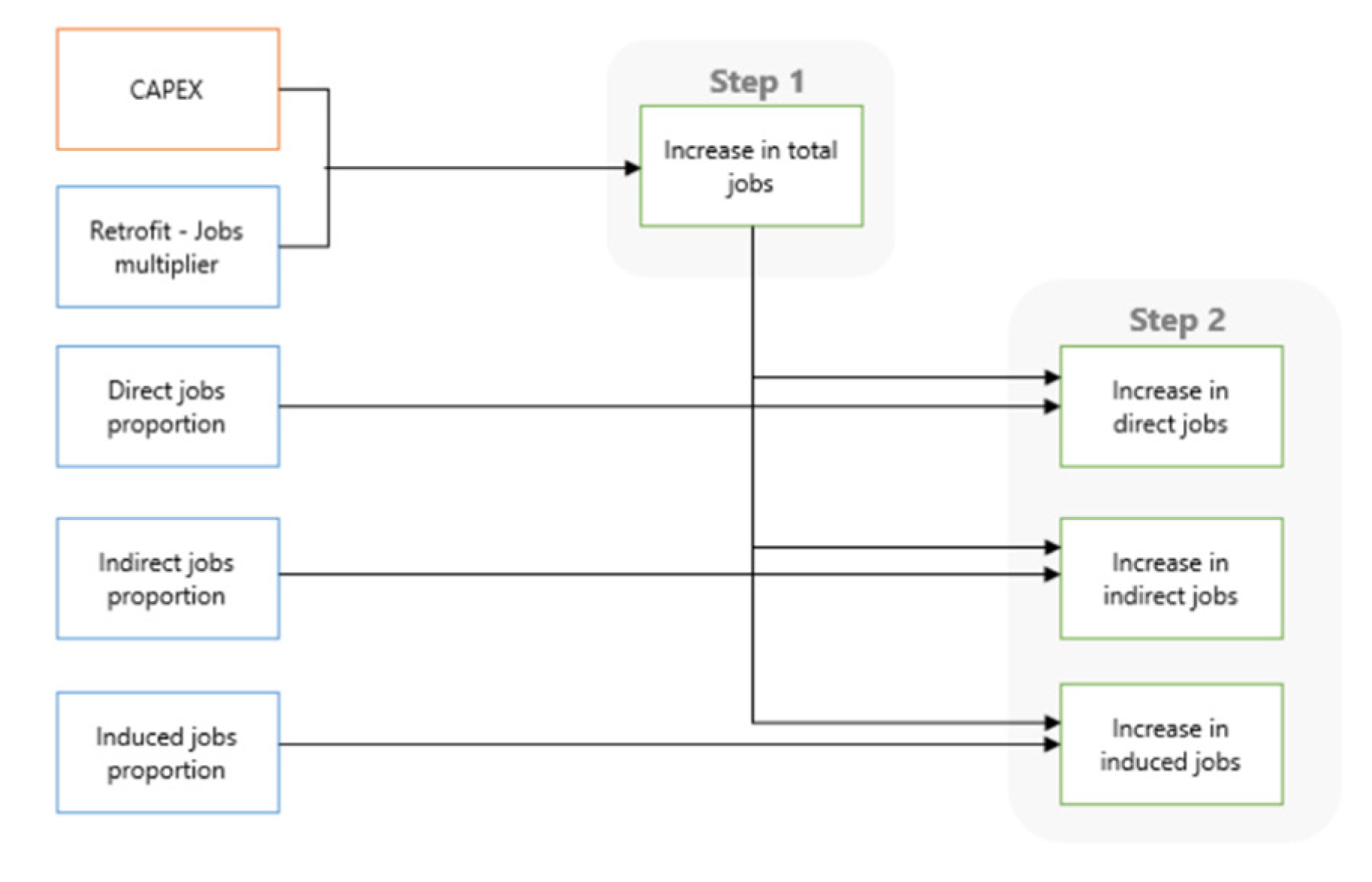
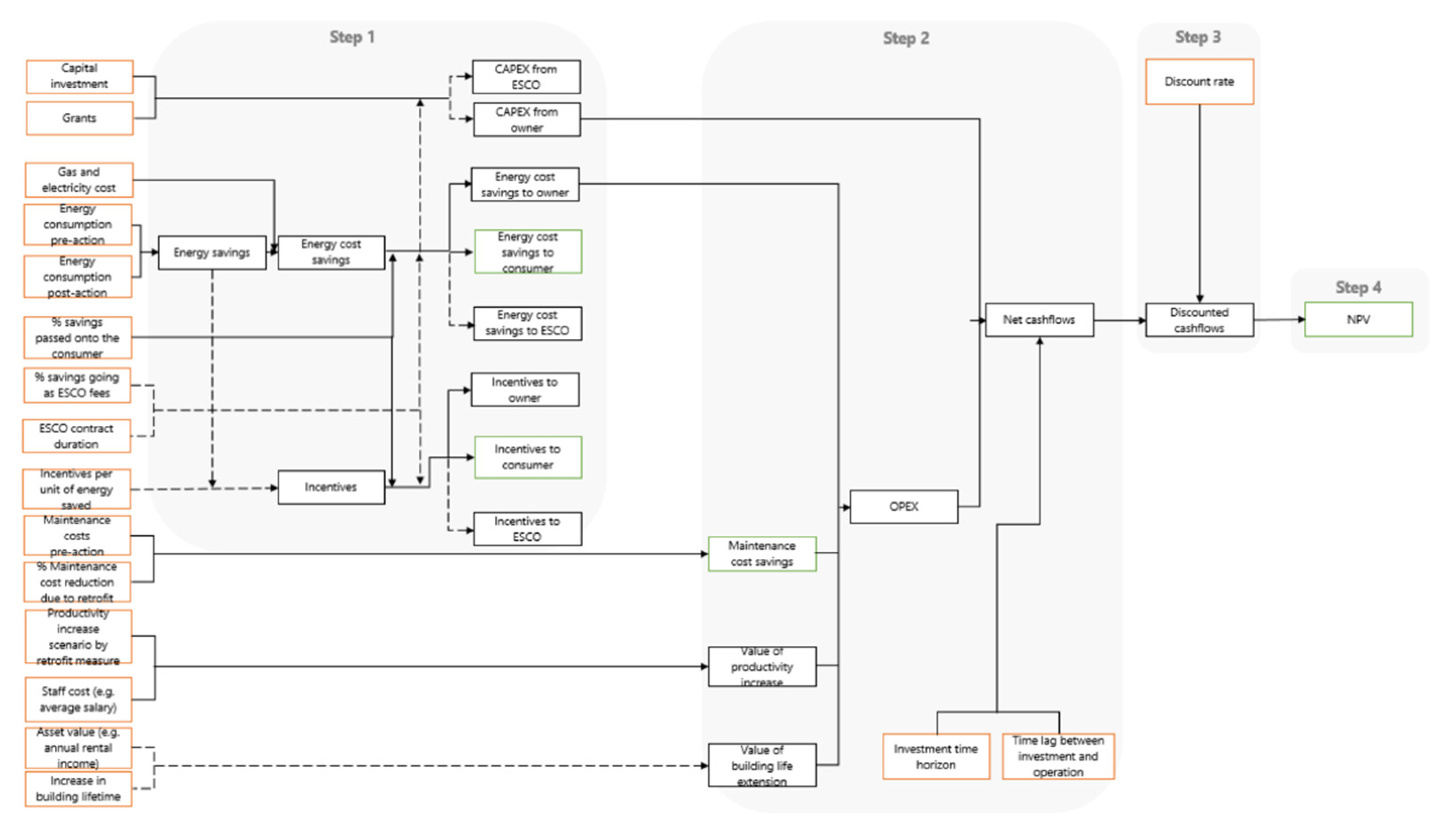
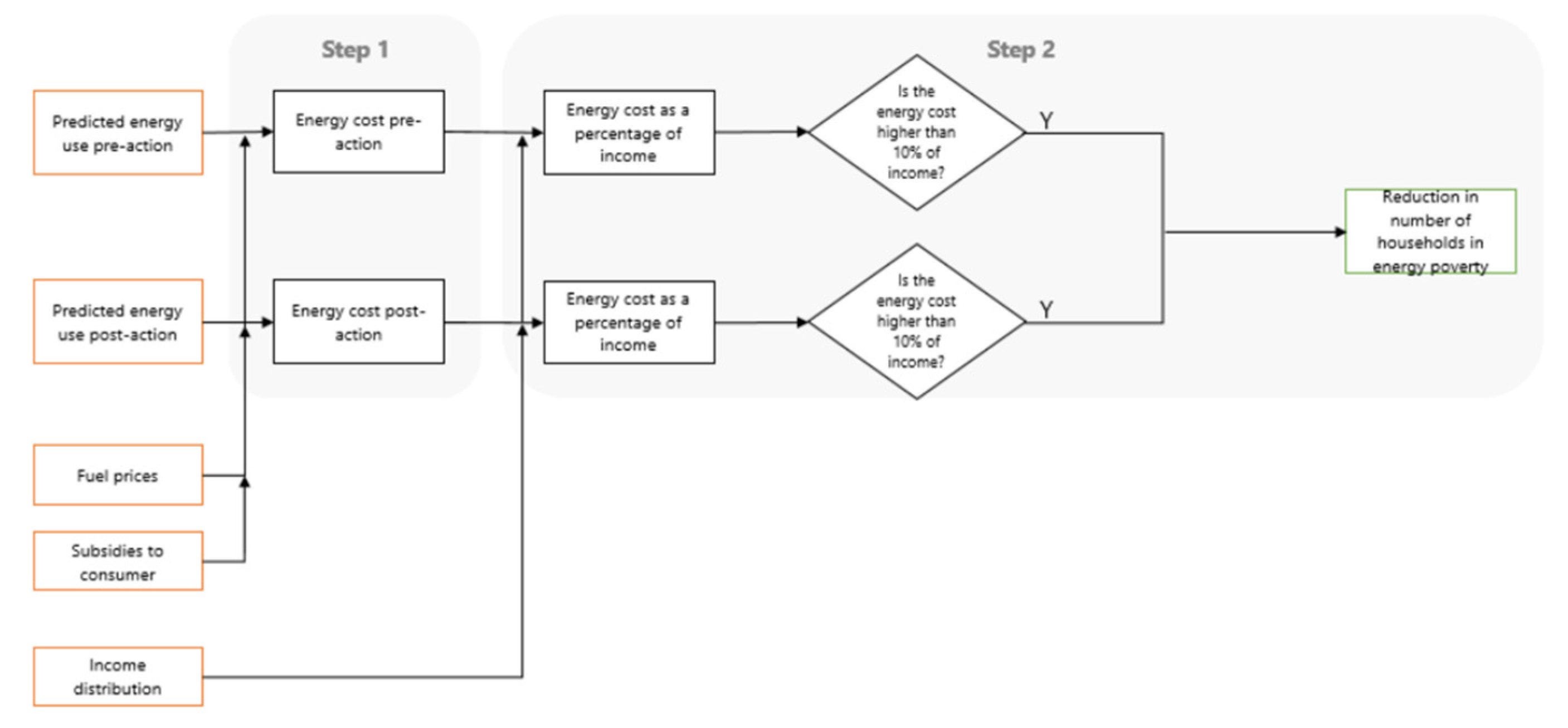

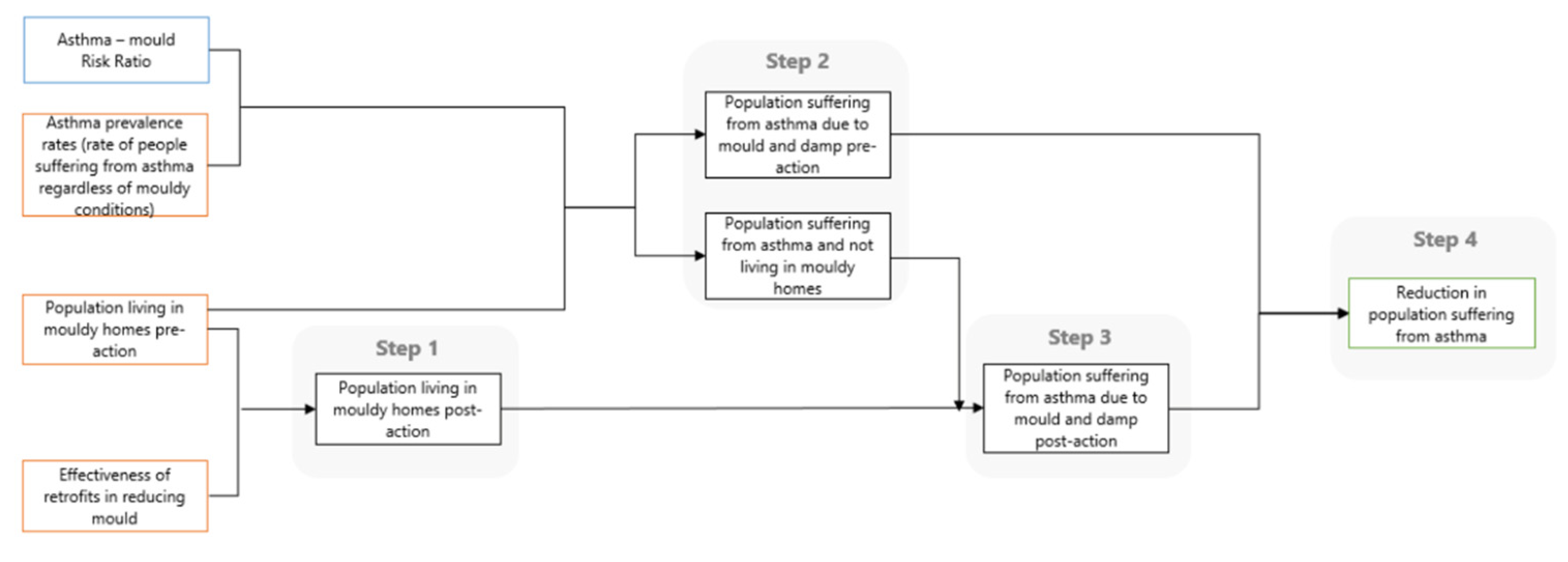
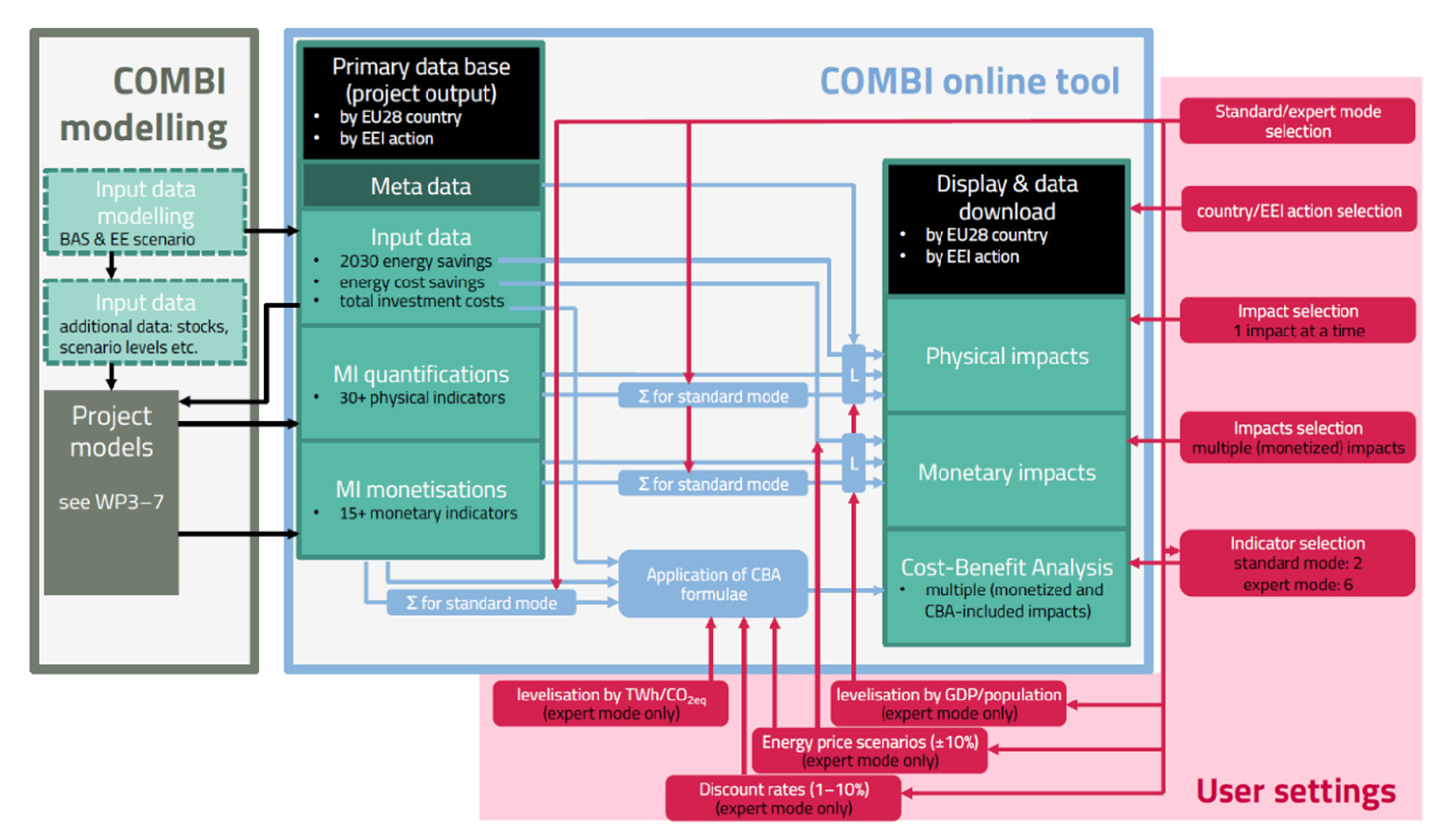
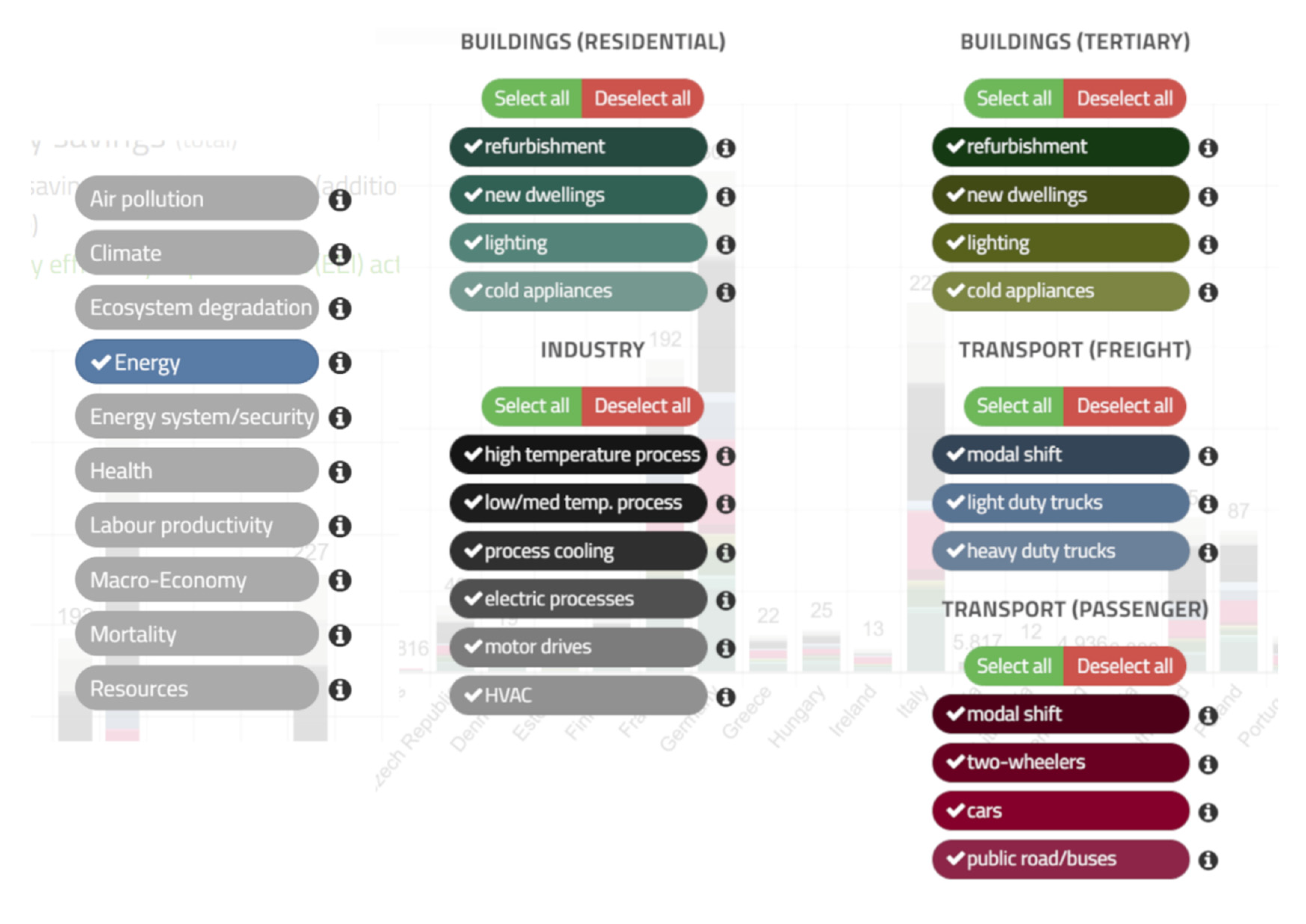
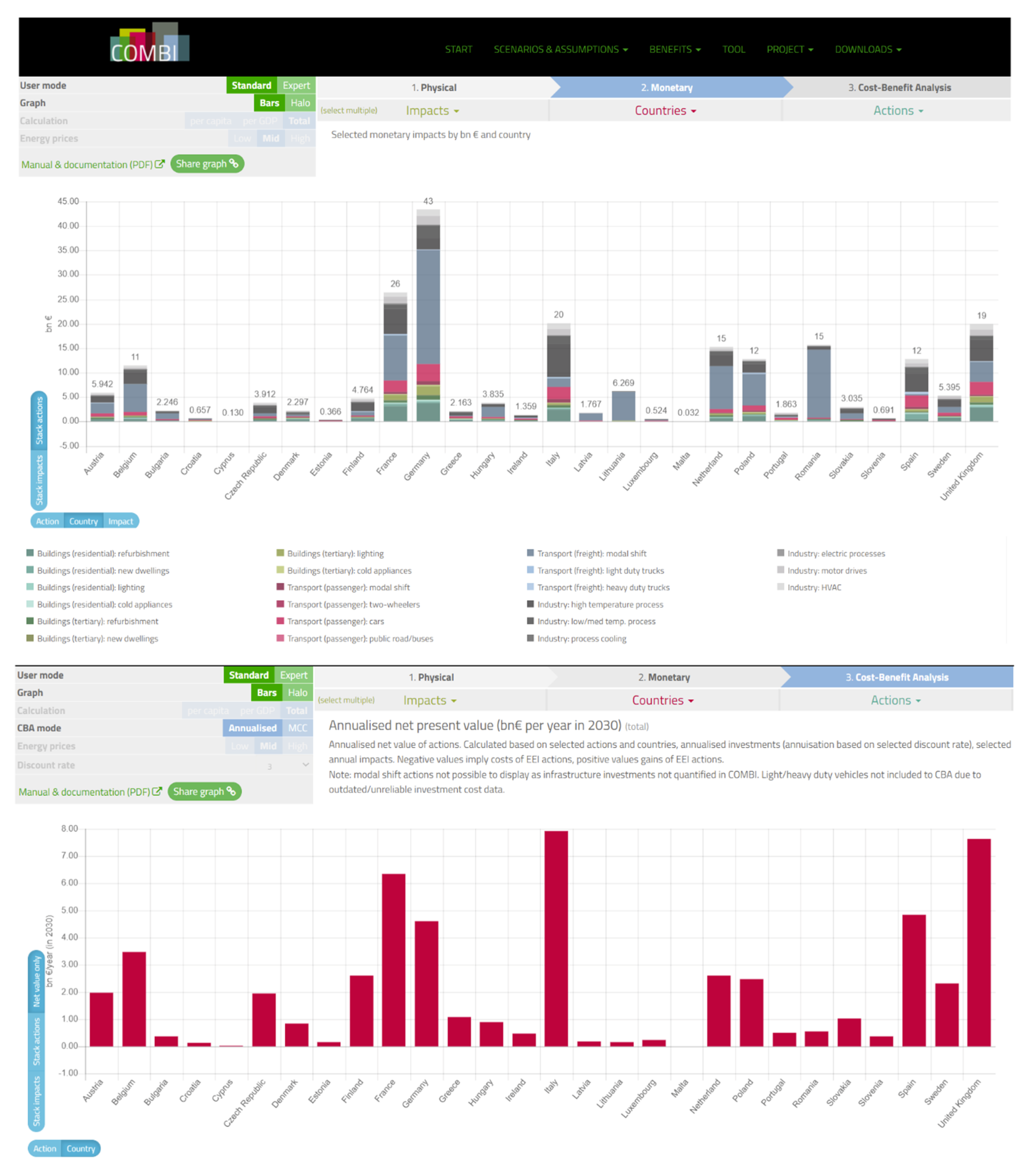
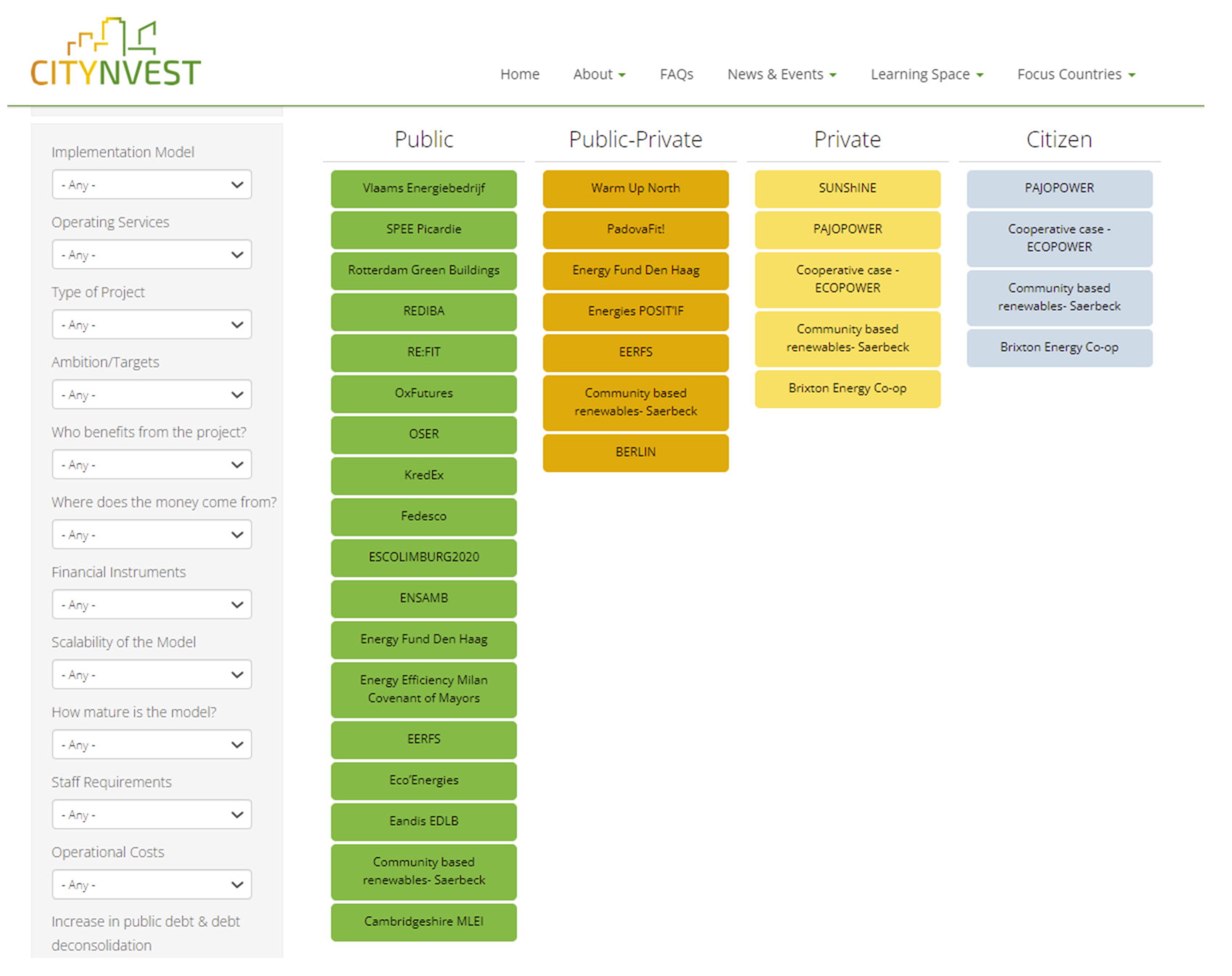
| Project | Description |
|---|---|
| C40 Global Network—Benefits of deep retrofits | A calculation tool is developed to assess several non-energy benefits of deep retrofit interventions, defining different approaches according to building use and functions (residential, offices, schools). In particular, some issues are targeted: GHG emissions, job creation, NPV, energy poverty, cold mortality and mould asthma. Three case studies are presented (New York, Milan and Copenhagen). |
| COMBI Project (Calculating and Operationalising the Multiple Benefits of Energy Efficiency in Europe) | An online assessment tool is implemented to evaluate multiple benefits of energy efficiency in order to quantify and monetize non-energy benefits, leading to the elaboration of a cost–benefit analysis. According to the selected country and to the features of EE interventions, more than 35 impacts are considered and assessed. The investigated fields are human health; ecosystems; polluting emissions; material footprints/resources impact; energy cost saving/available income effect; productivity; gross employment/GDP; public budgets; energy security and energy systems. |
| RenOnBill Project | The RenOnBill project includes the development of an energy renovation tool for the valuation of energy efficiency investments. This tool represents a particularly innovative element since it approaches the estimation of energy savings and financial profitability with a probabilistic approach that enables assessment of non-energy benefits, too. The considered methodology uses a scoring system to quantify the willingness to pay back investments in energy renovations. |
| Residential | Offices | Schools | |
|---|---|---|---|
| GHG | X | X | X |
| Jobs | X | X | X |
| NPV * | X | X | X |
| Energy Poverty | X | ||
| Cold Mortality | X | ||
| Mould Asthma | X |
| Category | Benefit | Pre-Retrofit | Post-Retrofit | %Change |
|---|---|---|---|---|
| GHG Emissions | Kg CO2eq per year | 24,638,257 | 14,166,998 | 42.50% |
| Kg CO2eq over project lifetime | 739,147,710 | 425,009,940 | 42.50% | |
| Job Creation | Total jobs | - | 1334 | - |
| Energy Cost Savings (USD) | Owner costs (per annum) | 7,659,495 | 4,404,210 | 42.50% |
| Additional Cost Savings (USD) | Total maintenance cost savings | 750,000 | 675,000 | 10.00% |
| Improved workers performance | - | 8,625,000 | - | |
| NPV (USD) | 3% discount rate | - | 21,661,673 | - |
| Category | Benefit | Pre-Retrofit | Post-Retrofit | %Change |
|---|---|---|---|---|
| GHG Emissions | Kg CO2eq per year | 1,397,898 | 920,232 | 34.17% |
| Kg CO2eq over project lifetime | 41,936,932 | 27,606,957 | 34.17% | |
| Job Creation | Total | - | 59 | - |
| Energy Cost Savings (Euro) | Consumer costs per household (per annum) | 382,512 | 291,643 | 23.76% |
| Additional Cost Savings (Euro) | Total maintenance cost savings | 246,949 | 172,864 | 30.00% |
| NPV (Euro) | 3% discount rate | - | 594,542 | - |
| Energy Poverty | No. of households | - | 3 | - |
| Cold Mortality | Premature deaths | - | 0.0003 | - |
| CVD | People affected by asthma | - | 0.78 | - |
| Category | Benefit | Pre-Retrofit | Post-Retrofit | %Change |
|---|---|---|---|---|
| GHG Emissions | Kg CO2eq per year | 855,332 | 696,233 | 18.60% |
| Kg CO2eq over project lifetime | 42,766,600 | 34,811,650 | 18.60% | |
| Job Opportunities | Total | - | 34 | - |
| Energy Cost Savings (DKK) | Consumer costs per household (per annum) | 5,577,234 | 4,514,570 | 19.05% |
| Additional Cost Savings (DKK) | Total maintenance cost savings | - | 6,148,560 | - |
| NPV (DKK) | 3% discount rate | - | 141,384,044 | - |
| Sector | Impact Indicators |
|---|---|
| Air Pollution | Human health |
| Eco-system acidification | |
| Eco-system eutrophication | |
| Air pollution: emissions | |
| Resource | Material footprint (sum of fossil fuels, minerals, biotics, unused extraction) |
| Life cycle-wide fossil fuel consumption | |
| Minerals | |
| Biotic raw materials | |
| Unused extraction | |
| Direct carbon emissions | |
| Carbon footprint (GWP, life-cycle emissions, including direct emissions) | |
| Social Welfare | Excess winter mortality attributable to inadequate housing |
| Indoor dampness/asthma | |
| Active days (impact through health—asthma, allergy, cardiovascular diseases, cold and flu, traffic time saved) | |
| Workforce performance | |
| Macro-Economic Impacts | Temporary (business-cycle) aggregate demand |
| Temporary (business-cycle) employment | |
| Temporary (business-cycle) budget effect | |
| Fossil fuel price effects | |
| ETS price effect | |
| Terms of trade effect | |
| Sectoral shifts | |
| Energy Security | Energy intensity |
| Import dependency | |
| Aggregated energy security | |
| Avoided electric power output and investment costs | |
| Derated reserve capacity rate |
| Statements |
|---|
| Energy expenses represent an important part of household income. |
| The market reflects higher prices for energy-efficient buildings. |
| Energy is promoted by mass media and in legislation. |
| Energy prices increase fast. |
| Penalties/restrictions (e.g., higher tax rates) are applied for non-energy-efficient properties. |
| The considered property achieves the Passive House standard. |
| The increase in comfort is related to the energy efficiency of the property. |
Publisher’s Note: MDPI stays neutral with regard to jurisdictional claims in published maps and institutional affiliations. |
© 2022 by the authors. Licensee MDPI, Basel, Switzerland. This article is an open access article distributed under the terms and conditions of the Creative Commons Attribution (CC BY) license (https://creativecommons.org/licenses/by/4.0/).
Share and Cite
Delponte, I.; Bianco, V.; Costa, V. The Role of Non-Energy Impact Assessment in Boosting Energy Efficiency and Urban Regeneration Projects: The RenOnBill Project and Experiences from Liguria Region. Energies 2022, 15, 4093. https://doi.org/10.3390/en15114093
Delponte I, Bianco V, Costa V. The Role of Non-Energy Impact Assessment in Boosting Energy Efficiency and Urban Regeneration Projects: The RenOnBill Project and Experiences from Liguria Region. Energies. 2022; 15(11):4093. https://doi.org/10.3390/en15114093
Chicago/Turabian StyleDelponte, Ilaria, Vincenzo Bianco, and Valentina Costa. 2022. "The Role of Non-Energy Impact Assessment in Boosting Energy Efficiency and Urban Regeneration Projects: The RenOnBill Project and Experiences from Liguria Region" Energies 15, no. 11: 4093. https://doi.org/10.3390/en15114093
APA StyleDelponte, I., Bianco, V., & Costa, V. (2022). The Role of Non-Energy Impact Assessment in Boosting Energy Efficiency and Urban Regeneration Projects: The RenOnBill Project and Experiences from Liguria Region. Energies, 15(11), 4093. https://doi.org/10.3390/en15114093







